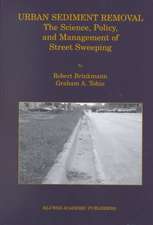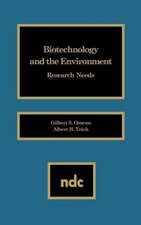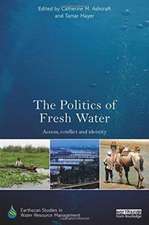Environmental Biotechnology: Reducing Risks from Environmental Chemicals through Biotechnology: Basic Life Sciences, cartea 45
Autor Gilbert S. Omennen Limba Engleză Paperback – 16 iun 2013
| Toate formatele și edițiile | Preț | Express |
|---|---|---|
| Paperback (1) | 1227.36 lei 6-8 săpt. | |
| Springer Us – 16 iun 2013 | 1227.36 lei 6-8 săpt. | |
| Hardback (1) | 1233.69 lei 6-8 săpt. | |
| Springer Us – iul 1988 | 1233.69 lei 6-8 săpt. |
Din seria Basic Life Sciences
- 5%
 Preț: 378.07 lei
Preț: 378.07 lei - 15%
 Preț: 647.73 lei
Preț: 647.73 lei - 5%
 Preț: 383.55 lei
Preț: 383.55 lei - 15%
 Preț: 649.06 lei
Preț: 649.06 lei -
 Preț: 401.03 lei
Preț: 401.03 lei - 5%
 Preț: 730.71 lei
Preț: 730.71 lei - 5%
 Preț: 736.92 lei
Preț: 736.92 lei - 5%
 Preț: 726.68 lei
Preț: 726.68 lei - 5%
 Preț: 729.26 lei
Preț: 729.26 lei - 18%
 Preț: 960.61 lei
Preț: 960.61 lei - 5%
 Preț: 375.85 lei
Preț: 375.85 lei - 5%
 Preț: 744.05 lei
Preț: 744.05 lei - 5%
 Preț: 740.58 lei
Preț: 740.58 lei - 5%
 Preț: 733.82 lei
Preț: 733.82 lei - 5%
 Preț: 719.38 lei
Preț: 719.38 lei -
 Preț: 397.59 lei
Preț: 397.59 lei - 5%
 Preț: 390.85 lei
Preț: 390.85 lei - 15%
 Preț: 657.57 lei
Preț: 657.57 lei - 5%
 Preț: 382.99 lei
Preț: 382.99 lei - 5%
 Preț: 400.56 lei
Preț: 400.56 lei - 5%
 Preț: 739.69 lei
Preț: 739.69 lei - 15%
 Preț: 657.25 lei
Preț: 657.25 lei - 18%
 Preț: 959.67 lei
Preț: 959.67 lei -
 Preț: 401.24 lei
Preț: 401.24 lei - 15%
 Preț: 658.88 lei
Preț: 658.88 lei - 5%
 Preț: 387.39 lei
Preț: 387.39 lei - 5%
 Preț: 376.95 lei
Preț: 376.95 lei - 5%
 Preț: 768.39 lei
Preț: 768.39 lei - 5%
 Preț: 735.83 lei
Preț: 735.83 lei - 15%
 Preț: 651.19 lei
Preț: 651.19 lei - 18%
 Preț: 1228.47 lei
Preț: 1228.47 lei - 15%
 Preț: 595.36 lei
Preț: 595.36 lei - 5%
 Preț: 736.39 lei
Preț: 736.39 lei - 5%
 Preț: 730.55 lei
Preț: 730.55 lei - 18%
 Preț: 960.30 lei
Preț: 960.30 lei - 5%
 Preț: 738.93 lei
Preț: 738.93 lei - 15%
 Preț: 662.16 lei
Preț: 662.16 lei - 15%
 Preț: 663.60 lei
Preț: 663.60 lei -
 Preț: 395.25 lei
Preț: 395.25 lei - 5%
 Preț: 739.13 lei
Preț: 739.13 lei - 15%
 Preț: 639.59 lei
Preț: 639.59 lei - 5%
 Preț: 377.52 lei
Preț: 377.52 lei - 5%
 Preț: 721.40 lei
Preț: 721.40 lei - 18%
 Preț: 1241.10 lei
Preț: 1241.10 lei - 18%
 Preț: 1233.69 lei
Preț: 1233.69 lei
Preț: 1227.36 lei
Preț vechi: 1496.78 lei
-18% Nou
Puncte Express: 1841
Preț estimativ în valută:
234.89€ • 244.32$ • 193.91£
234.89€ • 244.32$ • 193.91£
Carte tipărită la comandă
Livrare economică 14-28 aprilie
Preluare comenzi: 021 569.72.76
Specificații
ISBN-13: 9781489908261
ISBN-10: 1489908269
Pagini: 520
Ilustrații: XIV, 506 p.
Dimensiuni: 155 x 235 x 27 mm
Greutate: 0.72 kg
Ediția:Softcover reprint of the original 1st ed. 1988
Editura: Springer Us
Colecția Springer
Seria Basic Life Sciences
Locul publicării:New York, NY, United States
ISBN-10: 1489908269
Pagini: 520
Ilustrații: XIV, 506 p.
Dimensiuni: 155 x 235 x 27 mm
Greutate: 0.72 kg
Ediția:Softcover reprint of the original 1st ed. 1988
Editura: Springer Us
Colecția Springer
Seria Basic Life Sciences
Locul publicării:New York, NY, United States
Public țintă
ResearchCuprins
Microbial Ecology.- The Ecology of an Anaerobic Dechlorinating Consortium.- Performance of Biodegradative Microorganisms in Soil: Xenobiotic Chemicals as Unexploited Metabolic Niches.- Tracking Microorganisms and Genes in the Environment.- Relevant Advances in Molecular Biology.- Prospects for Laboratory Engineering of Bacteria to Degrade Pollutants.- Constructing Microbial Strains for Degradation of Halogenated Aromatic Hydrocarbons.- Stable Inheritance of Bacterial Plasmids: Practical Considerations in the Release of Organisms into the Environment.- Biotransformations of Mercury Compounds.- Minimizing Risks of Release of Microorganisms into the Environment.- Using Knowledge of Virulence Factors to Select or Design Organisms with Low Risk of Pathogenicity.- Applications to Chemical and Environmental Targets, Combining Microbial and Engineering Approaches.- Bioengineering Issues Related to in Situ Remediation of Contaminated Soils and Groundwater.- Bioremediation of Chemical Spills.- Microbiological Cleanup of Groundwater Contaminated by Pentachlorophenol.- Remediation of Multimedia Contamination from the Wood-Preserving Industry.- Preliminary Development of a Bench-Scale Treatment System for Aerobic Degradation of Trichloroethylene.- Biodegradation of Hydrocarbons in the Environment.- Discussion.- Complex Industrial Waste Sites.- Biological Approaches for Polychlorinated Biphenyl Degradation.- Exploitation of the High Affinity and Specificity of Proteins in Waste Stream Treatment.- Bioprocessing of Coal.- Anaerobic Fluidized-Bed Treatment of Hazardous Wastes.- Environmental Concerns Associated with the Design of Genetic Engineering Facilities.- The Role of Biotechnology in Pollution Control and the Role of Genetic Engineering in such Biotechnology Applications.- Assessment, Communication, and Management of Environmental Risks.- Balancing Regulatory Control, Scientific Knowledge, and Public Understanding.- Environmental Pollution Policies in Light of Biotechnological Assessment: Organisation for Economic Cooperation, United Kingdom, and European Economic Council Perspectives.- Environmental Protection Agency Actions to Stimulate Use of Biotechnology for Pollution Control and Cleanup.- Commentary: Some Issues in Biodegradation.- Corporate Panel.- Users and Providers of the New Technologies.- Public Participation.- Public Participation.- Superfund Strategies and Technologies: A Role for Biotechnology.- Concluding Remarks.- Concluding Remarks.- Poster Abstracts (Alphabetical).- 4-Chlorobenzoate Metabolism by Acinetobacter SP. 4-CB 1 and Its Relevance to Biodegradation of 4,4?-Dichlorobiphenyl.- Analysis of the Promoter for the Pseudomonas Putida catBC Operon.- Two Joint Office of Research and Development/Office of Solid Waste and Emergency Response Projects.- Modeling the Growth Kinetics and Substrate Utilization of a TCE-Degrading Microorganism.- A Shuttle System for the Rapid Introduction of Tracking and other Genes into the Chromosomes of Soil Bacteria.- The Molecular Microbial Ecology of a Catabolic Genotype in a Biological Treatment Process.- Pilot-Scale Biological Treatment of Contaminated Groundwater at an Abandoned Wood Treatment Plant.- Cloning and Sequencing of pseudomonas Genes Involved in the Demethylation of the Lignin Degradation Derivative, Vanillate.- A Novel Method to Detect Genetically Altered Microorganisms in the Environment.- Successful Microbial Remediations of Large-Scale Hazardous Waste Problems, Soils, and Waste Site Leachate.- Biodegradation of the Herbicide Alachlor in Liquid Culture and a Soil Slurry.-Microbial Volatilization of Selenium from Soils.- Transformation and Mineralization of Aroclor 1254.- Microbial Degradation of Chlorinated Unsaturated Fatty Acids.- Anaerobic Biodegradation Capabilities of Freshwater Lake Sediments: Influence of Temperature and Sulfate Concentration on the Degradation of 2,4-Dichlorophenol.- A New Method for Bacterial Strain Construction in Biodegradation of Xenobiotic Compounds.- The Organofluorophosphate Hydrolases of Tetrahymena thermophila and Rangia cuneata.- Fluidity of Plasmid DNA Fragments Involved in Biodegradation of Aromatic Hydrocarbons by pseudomonas putida Strain R5-3.- Biological Treatment of Petroleum Hydrocarbons and Polynuclear Aromatic Hydrocarbons in Waste Lagoons.- Enhanced Biological Removal of Toluene from Aqueous Systems.- On-Site Biological Treatment of Creosote-Contaminated Soils.- Risk Assessment of Application of Biodegradative Microorganisms for Hazardous Waste Destruction.- Anaerobic Treatment of Waste Streams from the Organic Chemicals Industry.- Biological Treatment for Soils Contaminated with Polychlorinated Biphenyls.- Degradation of Substituted Phenols by Immobilized Bacteria.- Metabolic Conversion of Lindane to Chlorophenols, Hydrophobic Acids, and More Hydrophilic Products by Streptomyces PSI.- Respirometric Study of Microbial Degradation of Phenol.- Field Demonstration of the Effectiveness of Land Application for the Treatment of Creosote-Contaminated Wastes.- The Land Treatability of Petroleum Refinery Waste Constituents.- Use of Catabolic Mutants of Pseudomonas Cepacia AC1100 to Isolate Genetic Elements Responsible for 2,4,5-Trichlorophenoxyacetic Acid Degradation.- Biological Treatment of Organic Contaminants Using Submerged Fixed-Film Reactors.- Monoclonal Antibodies for Detection of Environmental Contamination: An Immunoassay for Dioxin.- Modeling the Methane and Toxic-Degradation Kinetics of Methane-Oxidizing Biofilm Reactors.- Two-Stage Degradation of Parathion by Flavobacterium Sp. and Pseudomonas Sp..- Bacterial Degradation of Chlorinated Biphenyls.- The Yeast CUP1 Gene: A Model for Biological Detoxification of Heavy Metal Effluents.- Degradation of Nitroguanidine Wastewater Components.





















